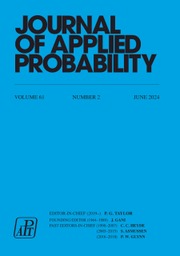No CrossRef data available.
Article contents
On the time behaviour of Okazaki fragments
Part of:
Mathematical biology in general
Special processes
Physiological, cellular and medical topics
Published online by Cambridge University Press: 14 July 2016
Abstract
Core share and HTML view are not available for this content. However, as you have access to this content, a full PDF is available via the ‘Save PDF’ action button.
We find explicit analytical formulae for the time dependence of the probability of the number of Okazaki fragments produced during the process of DNA replication. This extends a result of Cowan on the asymptotic probability distribution of these fragments.
MSC classification
Primary:
60K05: Renewal theory
- Type
- Research Papers
- Information
- Copyright
- © Applied Probability Trust 2006
References
Andrews, G. (1976). The Theory of Partitions (Encyclopaedia Math. Appl. 2). Addison-Wesley, Reading, MA.Google Scholar
Cowan, R. (2001). A new discrete distribution arising in a model of DNA replication. J. Appl. Prob.
38, 754–760.CrossRefGoogle Scholar
Cowan, R. (2003). Stochastic models for DNA replication. In Handbook of Statistics, Vol. 21, eds Shanbhag, D. N.
et al., North-Holland, Amsterdam, pp. 137–166.Google Scholar
Cowan, R. and Chiu, S. N. (1994). A stochastic model of fragment formation when DNA replicates. J. Appl. Prob.
31, 301–308.CrossRefGoogle Scholar
Lachal, A. (2003). Some probability distributions in modeling DNA replication. Ann. Appl. Prob.
13, 1207–1230.CrossRefGoogle Scholar
Piau, D. (2000). Quasi-renewal estimates. J. Appl. Prob.
37, 269–275, 1171–1172.CrossRefGoogle Scholar


